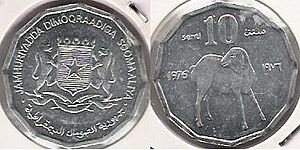Somali shilling facts for kids
Quick facts for kids Somali shilling |
|||
|---|---|---|---|
|
|||
| ISO 4217 Code | SOS | ||
| User(s) | |||
| Subunit | |||
| 1⁄100 | Senti, cents or centesimi | ||
| Symbol | Sh.So. | ||
| Coins | 5, 10, 50 cents, 1 shilling | ||
| Banknotes | 5, 10, 20, 50, 100, 500, 1000, 5000, 10,000 shillings | ||
The Somali shilling (Sh.So.) is the official currency of Somalia. It's like the money you use to buy things there. This currency is divided into 100 smaller parts called senti (in Somali), cents (in English), or centesimi (in Italian).
Contents
Understanding the Somali Shilling
How the Shilling Started
The shilling has been used in parts of Somalia since 1921. Back then, it was called the East African shilling in the area controlled by Britain.
After Somalia became independent in 1960, two different currencies were being used: the East African shilling and another one called the somalo. Both had the same value. In 1962, these were replaced by the new Somali shilling. The smaller units were called cents or senti, and the main units were shillings.
Paper Money: Banknotes
On October 15, 1962, the National Bank of Somalia started printing banknotes. These were in values like 5, 10, 20, and 100 shillings.
Over the years, different banks in Somalia printed new versions of these notes. In 1975, the Somali National Bank took over. Later, in 1978, the Central Bank of Somalia began issuing the notes.
New values were added over time. For example, 50-shilling notes came out in 1983, followed by 500-shilling notes in 1989, and 1000-shilling notes in 1990. There was even a plan in 1990 to change the value of the currency, but it didn't fully happen.
Metal Money: Coins
At first, people used coins from the older East African shilling and somalo currencies. In 1967, Somalia started making its own coins. These coins were for 5, 10, and 50 cents, and 1 shilling.
Later, in 1976, new coins were made with Somali names for the values. These were for 5, 10, and 50 senti, and 1 shilling.
The Shilling's Journey Through Time
Before the Civil War
For many years, the Somali shilling's value was linked to other major currencies. In 1967, it was linked to the United States dollar. This meant that its value would change if the dollar's value changed.
Over the years, the Somali shilling's value changed many times. Sometimes it became less valuable compared to the US dollar. For example, in 1982, one US dollar was worth about 16.50 shillings. By the end of 1990, one US dollar could be exchanged for 3,470 shillings! This shows how much its value went down.
When There Was No Central Control
In the early 1990s, Somalia faced a civil war. This caused the government and the Central Bank of Somalia to stop working properly. Without a central bank, the value of the Somali shilling dropped a lot.
Different groups started printing their own versions of the currency. This made the problem worse because there was too much money, and it lost its value quickly. People had to carry huge bundles of cash just to buy small things. Because of this, the United States dollar became very popular for bigger purchases.
Bringing Back Order: Regulation
In the late 2000s, Somalia's new government worked to bring back the Central Bank of Somalia. This bank's job is to manage the country's money and keep its value stable.
Even with the Central Bank trying to help, the US dollar is still widely used in Somalia. However, the Central Bank is working to take full control of the money supply. They want to replace the old money printed by private groups with new, official currency. This will help stop prices from rising too fast.
Thanks to better safety in Somalia, many Somalis living abroad have started to invest money back home. This has helped the Somali shilling become much stronger. By 2014, its value had increased by almost 60% against the US dollar in just one year! It was one of the strongest currencies in the world at that time.
Today, the US dollar is still very important in Somalia, especially for electronic payments like those made by phone.
More to Explore
- Economy of Somalia
- Somaliland shilling
- East African Shilling
- Somalo
Images for kids




